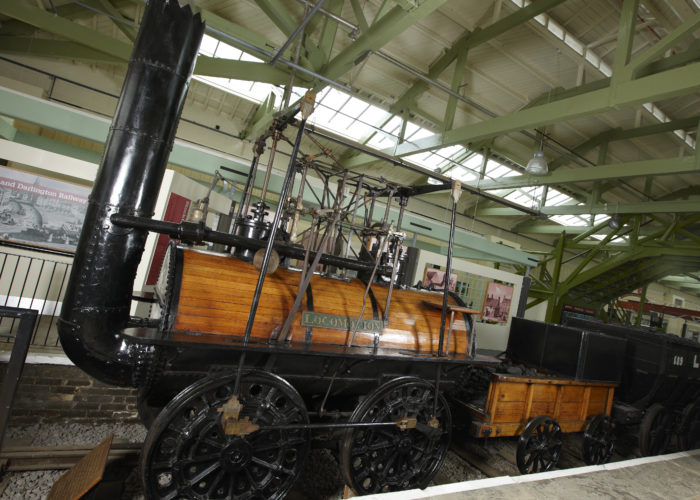Locomotion No. 1
Theme: Transporting revolution, The impact of industry, Medicine, science and the people, Economic and technological revolution, Trade, tariffs and taxes
This is the first steam powered railway engine to run on a public railway. It was designed by George Stephenson and sparked a transport revolution that transformed the lives and fortunes of people across Britain and the wider world.
Today we take it for granted that we can board a train and travel anywhere in the country, but in the early 1800s, inland transport was limited mainly to horse drawn carriages and canal boats. The invention of the steam engine changed everything. Steam engines were initially designed for use in mining operations, where pumps and haulage power were very important, and prototypes of steam locomotives first emerged around coal and ironworks in South Wales and Shropshire. Rail travel as we know it today began in the North East of England with the opening of the famous Stockton & Darlington Railway. This was a steam hauled railway, open to the public and designed to carry passengers as well as goods. It was the first of its kind in the world.
Crowds of people turned out to witness the opening on 27 September 1825. They had never seen anything like it before. Driven by George Stephenson himself, Locomotion I hauled wagons of coal and flour and a special carriage for passengers called Experiment. The train is thought to have reached speeds of 15 mph.
The success of the Stockton and Darlington Railway, coupled with demand for improved transport and plentiful investment, led to a network of railways which transformed Britain and stretched around the world. Goods could now be quickly and affordably transported across the country, and to coastal ports for shipping. New industries and towns soon developed and people from all walks of life travelled to previously unreachable areas for work, business and pleasure.
Did you know..?
Not everyone welcomed the railways. Farmers and landowners protested that they would blight the land, and could frighten the livestock, turning milk sour and stopping hens from laying. Others were concerned that the free movement of the lower classes could threaten the country’s very moral fibre!
Use our Classroom resources to investigate this object and the theme of Transport further.
Highlights:
- Using objects, artworks and other sources to find out about the past
- Enquiry: How was transport different in the past?
- Enquiry: A transport revolution?
- Transport pairs
- Objects personified
And much more…
Sources & acknowledgements
This object description and its related educational resources were researched and written by our team of historians and education specialists. For further information see the item’s home museum, gallery or archive, listed above.
- Related resources
- Enquiry Questions
-
Education overview
You can access a range of teachers resources related to this object and more on our education page.
Please also see our glossary of terms for more detailed explanations of the terms used.
-
Curatorial info
- Originating Museum: Head of Steam, Darlington Railway Museum, UK (on loan from the National Railway Museum, York, UK)
- Production Date: 1825
- Creator: Robert Stephenson and Company
- Creation Place: Newcastle-Upon-Tyne
-
Use this image
You can download this image for personal and educational use but please take note of the license type and rights holder information.
- Rights Holder: On loan to Head of Steam – Darlington Railway Museum from the National Railway Museum
- License Type:
Find it here
This object is in the collection of Head of Steam – Darlington Railway Museum



